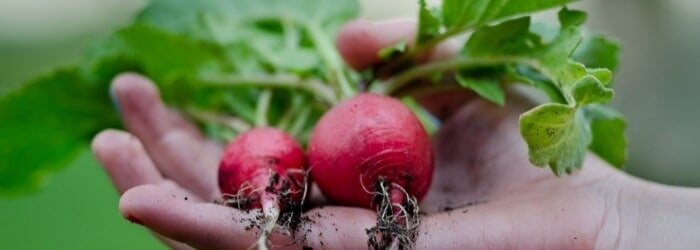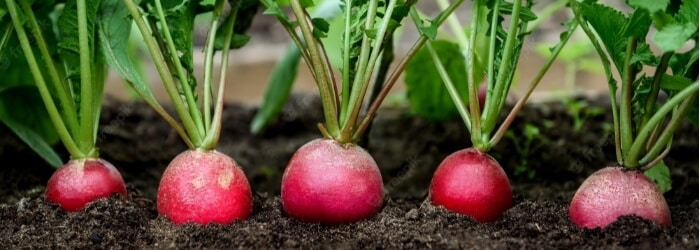Radishes
are becoming increasingly popular among indoor growers for a few reasons, including their ease of cultivation and few growing requirements. Once you have a suitable indoor growing space and adequate lighting, you are on your way to having a successful indoor growing experience with radishes.
If you are a beginner grower looking to try radish growing indoors or you are looking to improve your existing growing method, this blog is for you. We have created this practical guide to show you all you need to know about growing radishes successfully indoors.
What Are The Growth Requirements For Radishes?
The first step to growing radishes indoors is understanding the growth requirements of the plants. Let’s take a look at the requirements.
Soil
Radish plants thrive most effectively in moist soil conditions. Dry soil forces the roots to die, and the plants do not recover in most cases, while wet soil leads to root rot. You can go for a quality potting mix sold in stores or make your own from scratch. Either way, ensure you have soil that is loamy than clayey with no stones. You can also throw in some compost or well-rotted manure during planting.
Lighting
Radishes require minimal sunlight compared to fruiting crops like peppers and tomatoes. However, they need five to six hours of daylight to grow optimally. Therefore, they are pretty tolerant of shades. You can place them on your windowsill. In the absence of natural sunlight, you can adopt a strong grow light that can deliver the equivalent of over six hours of direct sunlight [DLI of 18+ mol/m²/day].
Watering
It is best to regularly and consistently water your radish plants to keep the soil and plants moist. Radishes do not like overly wet or dry soil and need 1 inch (2.5 cm) of water per week is sufficient. Keep the soil moist, but not completely wet. Keeping the plants dry for a long time before watering can lead to roots cracking, ultimately killing the plants.
Temperature
As a cool-season root crop, radishes grow best in short days. The seed germination temperature ranges between 40-95 oF while the optimum seed germination temperature range between 55-85 oF. Anything lower or higher causes slow germination. Regarding growth, the best growth temperature for high-quality radish plants is 50-70 oF, but you can also grow them in the 40-90 oF temperature range.
Equipment
In addition to your viable radish seeds, you need other equipment, including planting pots or containers with drainage holes, a garden fork, a watering can with a fine rose, and a misting spray (not compulsory).

How to grow radishes?
Radish plants grow optimally when sown right into the soil compared to when transplanted. So, instead of planting in seed trays, sow the seeds directly into the pots. You can follow the steps below for a successful indoor radish growing;
- Fill your planting pots or container with soil.
- Sprinkle your viable radish seeds (3 to 5) into the soil in your container, and use a garden fork to gently pull the soil 1/2 or 1/4 inch over the seeds.
- Water generously and wait for the seedlings to germinate.
- The first sets of seedlings will emerge between 3 to 10 days.
- Thin out the seedlings to ensure a two-inch space between two seedlings or 3-4 inches in the event of Daikon and other large varieties.
- You can use the thinned-out plants for salads and other microgreens.
NB: Your pots should be at least 6 inches deep if you are planting regular varieties like Purple Plum and Cherry Belle. The diameter depends on the number of radish plants you want to have in each pot.
For example, a 12-inch-wide pot can accommodate 6-7 plants of regular radish plants or four plants of large radish plants.
How Long Do Radishes Take To Grow?
How long it takes a radish plant to attain full maturity after germination varies depending on the cultivars. For example, the early maturing cultivars take 20-40 days to mature after planting. Similarly, varieties like the French Breakfast and Cherry Belle takes 23-30 days to harvest. However, Asian radishes such as Daikon take longer–60-70 days in most cases.
It is important to know when to harvest your matured radish plants. Leaving matured radishes unharvested leads to woody, peppery, and cracked plants. It is best to harvest them when the leaves are young and green.

In Conclusion
Growing radishes indoors can be an enjoyable experience if properly done. Besides improving your indoor growing skills and experience, you also get a year-round supply of great-tasting, healthy, homegrown radishes for your consumption. Growing radishes indoors require intermediate care. Besides meeting the growth requirements, you will have to sprout, thin, and prune to nurture your radish plants to full maturity. Once these are done, all you have to do is watch your radish plants bloom.
Source link
